Revercecaptcha.com (Chrome, Firefox, IE, Edge)
Revercecaptcha.com Removal Guide
What is Revercecaptcha.com?
Revercecaptcha.com – a treacherous website that you should never visit

Revercecaptcha.com is a deceptive site that displays various misleading prompts seeking to trick you into accepting its notifications. If you do that, the push notification virus will deliver tons of advertisements directly to your screen or desktop. Please don't push the Allow button on this or any other shady portal.
The main goal of such dubious websites is to generate revenue by generating traffic to affiliated sites. They can do that either by showing you alluring ads or by causing sudden redirects, where you're forced to visit sponsored portals without even clicking on any ads.
This could lead to dangerous websites with ill intentions. The initial redirect to Revercecaptcha.com is probably caused by an adware infection, of course, if you didn't visit this page willingly. This article contains a broad summary of the culprit, its removal guides, and system repair options.
| name | Revercecaptcha.com |
|---|---|
| Type | Adware, push notification virus, PUP |
| IP address | 5.8.34.12 |
| Purpose | Generate internet traffic to portals that pay the most |
| Symptoms | Ads showing up as notifications, sudden redirects to untrustworthy pages, sluggish device performance, slower browsing speed |
| Risks | PUP installation, malware[1] infections, privacy issues, monetary losses, identity theft |
| Distribution | File-sharing platforms, deceptive ads, fake Flash Player updates, software bundles |
| Elimination | To quickly and safely remove cyber infections, you must use reliable anti-malware software |
| System repair | PUPs can alter system files, resulting in freezing, severe lag, BSoDs, and other system failures. To restore any changes and get your device back on its feet, please use the all-in-one FortectIntego system diagnostics tool |
As stated before, redirects to push notification virus websites like the culprit of the article, Forlumineontor.com, Spination.top, Mycoolnewz.com, and a myriad of others, are usually caused by an adware. It's considered less dangerous than malware as it is categorized as a potentially unwanted program[2] (PUP).
These websites try to trick you into accepting their notifications by any means they can. The page can display various enticing backgrounds and show misleading prompts, urging you to push the Allow button to:
- enter the site,
- confirm that you're not a robot,
- watch a video,
- continue downloading,
- prove that you're over 18 years old, etc.
Please note one thing, if a website asks to accept its notifications by showing any of the abovementioned or similar prompts, it's an untrustworthy site. Don't press the Allow button, close the tab, clear your browsing history, and never visit that page again.
If you enable notifications on Revercecaptcha.com or similar shady portals, you will start receiving deceptive ads directly on your screen or the top-right or bottom-right corners of your desktop. In most cases, they are deceptive as the ad has nothing to do with the site you'll end up on.
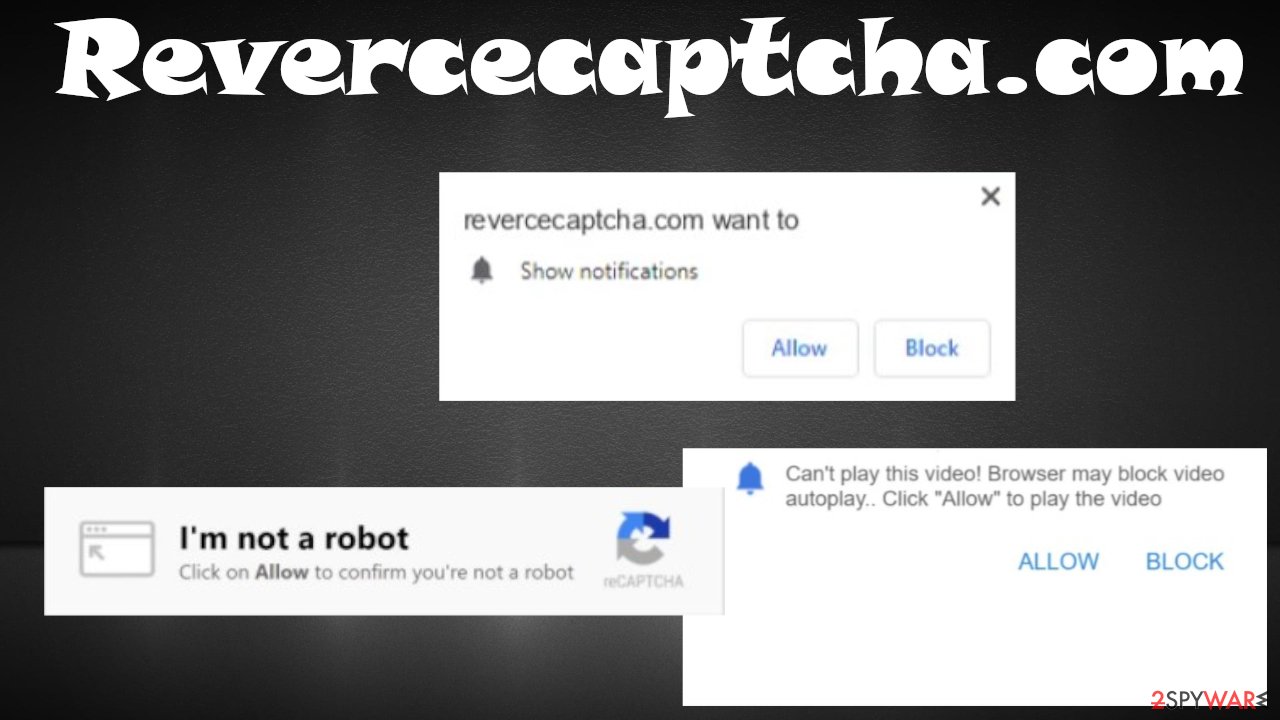
Thus they should never be clicked on. But push notification viruses can make you visit a site of their choice. They can cause sudden redirects to any of their affiliated sites on demand. That's why you should accept notifications only from legitimate, trustworthy sources.
If you've pressed the Allow button and now Revercecaptcha.com virus is causing all kinds of troubles, you have to remove it immediately. For that, use our comprehensive guides posted below. Then run a full system scan with reliable anti-malware software such as SpyHunter 5Combo Cleaner or Malwarebytes to eliminate adware along with any other suspicious or malicious files.
Since infections leave their marks on the device in the system files and settings, you have to perform system diagnostics to ensure that your device runs smoothly. IT experts[3] highly recommend using the FortectIntego software after any virus removal to restore the Registry and other core system values.
Please stay away from Flash Player installers or updates as they carry infections
Most people don't know that Adobe discontinued its support for Flash Player on December 31, 2020. The once-popular software is now obsolete. But cybercriminals are still trying to trick gullible people into downloading fake Flash Player updates or installers.
Prompts or ads suggesting to update or install this software are commonly seen on treacherous websites. Once a user clicks on them, they might be redirected to a page where they will be forced to install some software (usually a PUP), or malware could be installed instantly.
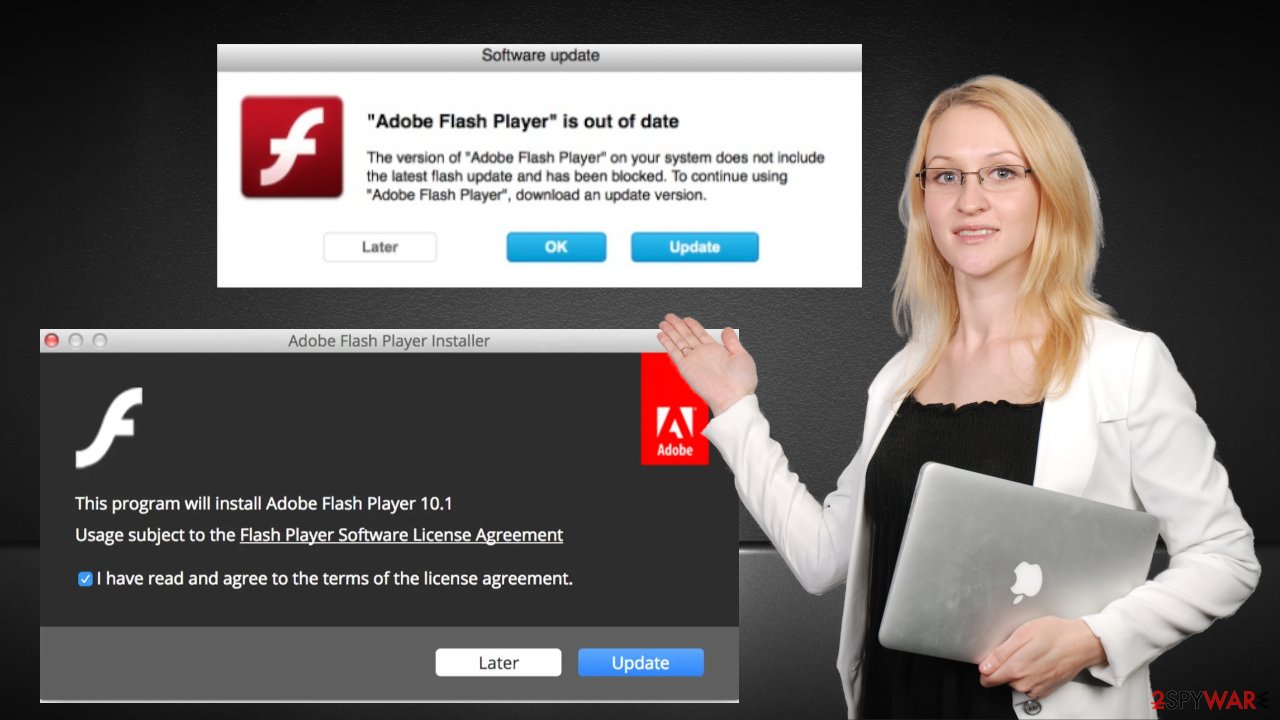
Fake Flash Player installers/updates could be carrying all sorts of PUP, such as adware, unnecessary toolbars, browser hijackers, or even malware, including ransomware, keyloggers, Trojans, etc. If you ever encounter such deceptive prompts, please leave the page immediately and never visit it again.
Remove Revercecaptcha.com virus swiftly with proper AV tools
We've said a million times, and we'll say it again – you should enable push notification only on legitimate sources that you frequently visit. Revercecaptcha.com virus will slow down your device in use, bombard you with deceptive ads, and could cause all kinds of similar or worse infections.
First, to begin the removal process, you have to get rid of the adware or other PUP that redirected you to the culprit's portal in the first place. The best way to remove any cyber infection is to perform a full system scan with a trustworthy security tool.
Then use our free instructions below to remove Revercecaptcha.com notifications from your browser. And lastly, to ensure a stable working environment, perform system diagnostics to delete tracking cookies from shady portals and restore altered system settings.
You may remove virus damage with a help of FortectIntego. SpyHunter 5Combo Cleaner and Malwarebytes are recommended to detect potentially unwanted programs and viruses with all their files and registry entries that are related to them.
Getting rid of Revercecaptcha.com. Follow these steps
Stop browser notifications
Remove unwanted notifications from Google Chrome (desktop):
- Open Google Chrome browser and go to Menu > Settings.
- Scroll down and click on Advanced.
- Locate Privacy and security section and pick Site Settings > Notifications.
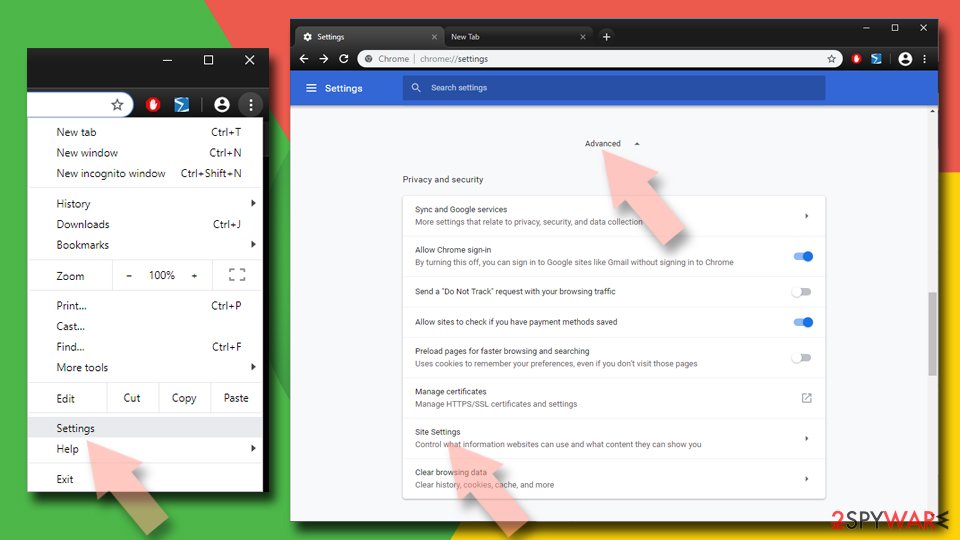
- Look at the Allow section and look for a suspicious URL.
- Click the three vertical dots next to it and pick Block. This should remove unwanted notifications from Google Chrome.
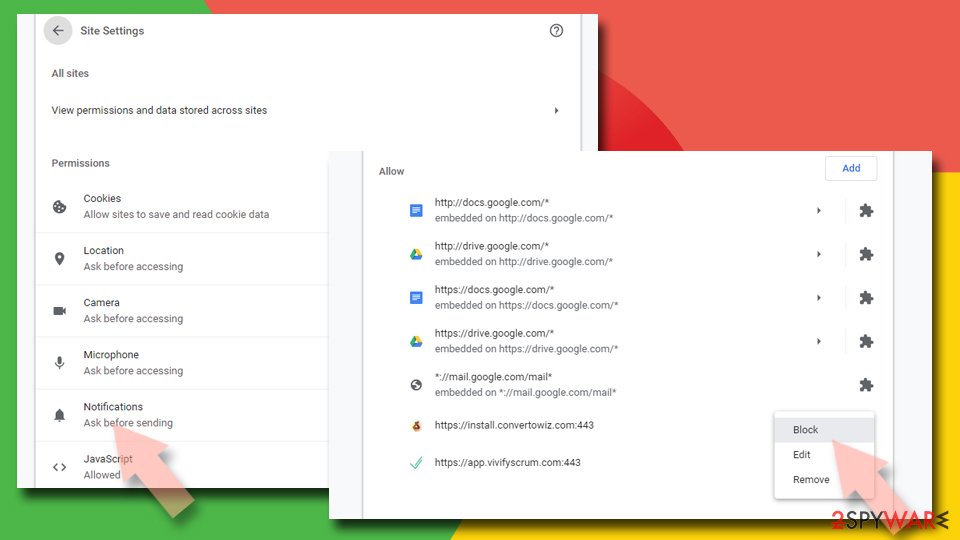
Remove unwanted notifications from Google Chrome (Android):
- Open Google Chrome and tap on Settings (three vertical dots).
- Select Notifications.
- Scroll down to the Sites section.
- Locate the unwanted URL and toggle the button to the left (Off setting).
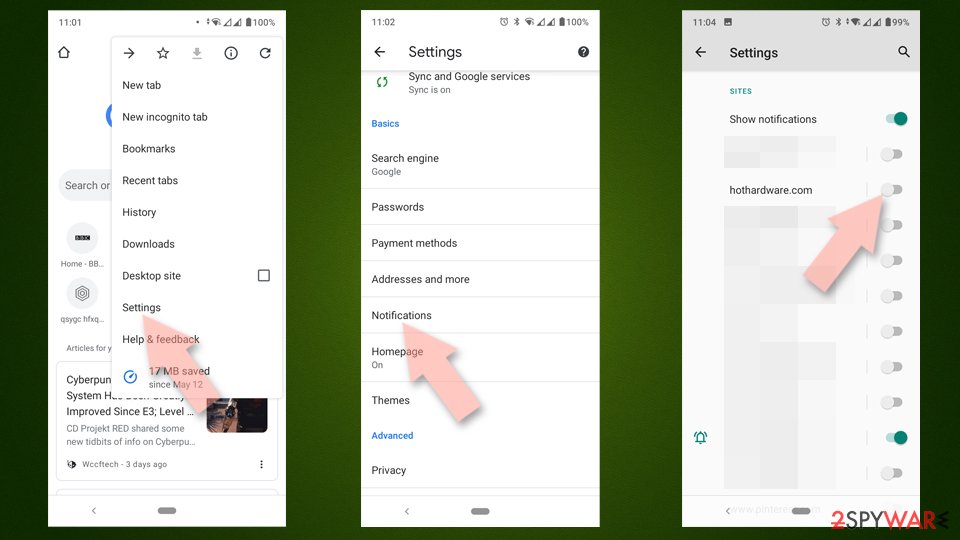
Remove unwanted notifications from Mozilla Firefox:
- Open Mozilla Firefox and go to Menu > Options.
- Click on Privacy & Security section.
- Under Permissions, you should be able to see Notifications. Click the Settings button next to it.
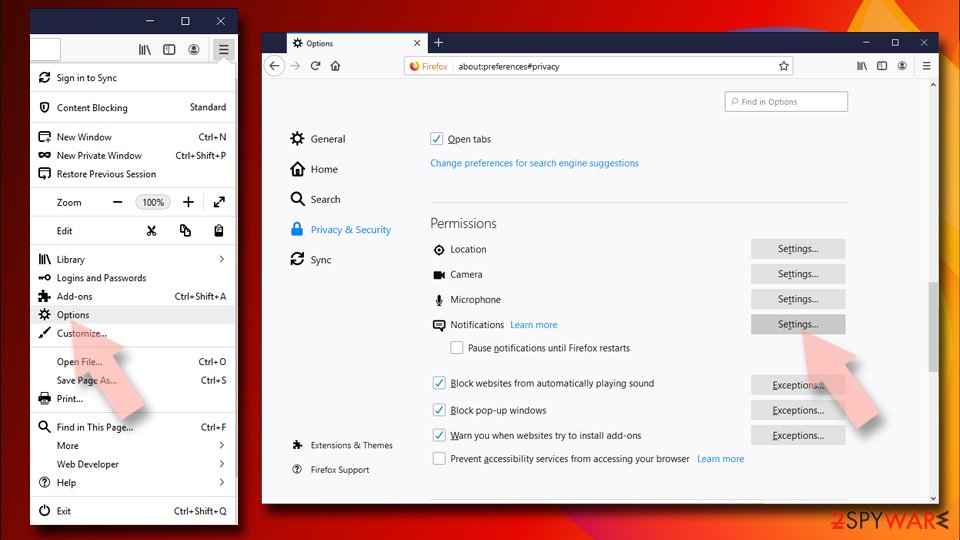
- In the Settings – Notification Permissions window, click on the drop-down menu by the URL in question.
- Select Block and then click on Save Changes. This should remove unwanted notifications from Mozilla Firefox.
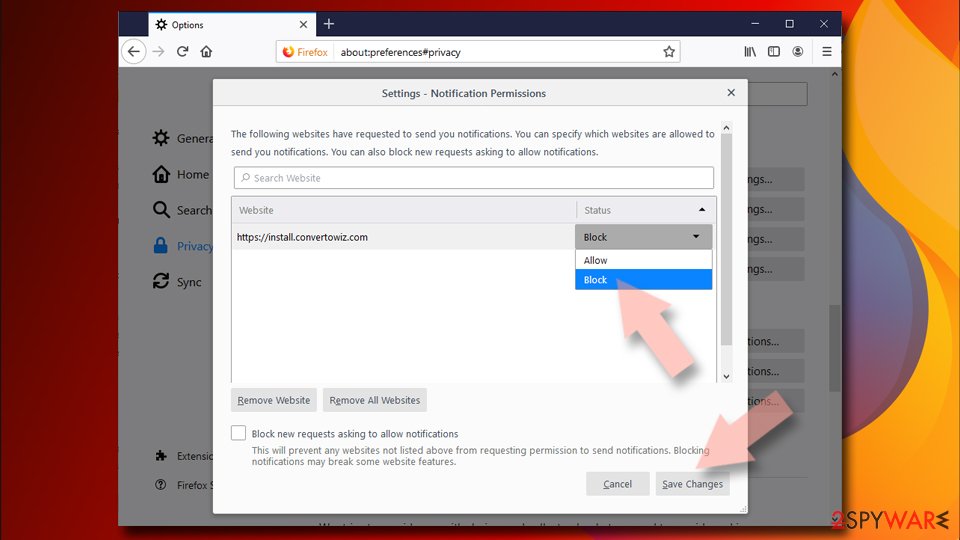
Remove unwanted notifications from Safari:
- Click on Safari > Preferences…
- Go to the Websites tab and, under General, select Notifications.
- Select the web address in question, click the drop-down menu and select Deny.
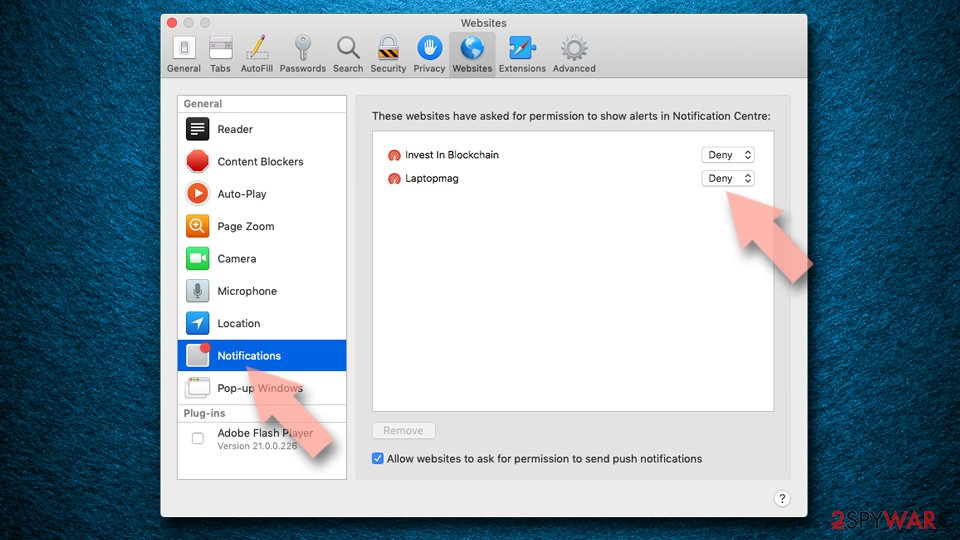
Remove unwanted notifications from MS Edge:
- Open Microsoft Edge, and click the Settings and more button (three horizontal dots) at the top-right of the window.
- Select Settings and then go to Advanced.
- Under Website permissions, pick Manage permissions and select the URL in question.
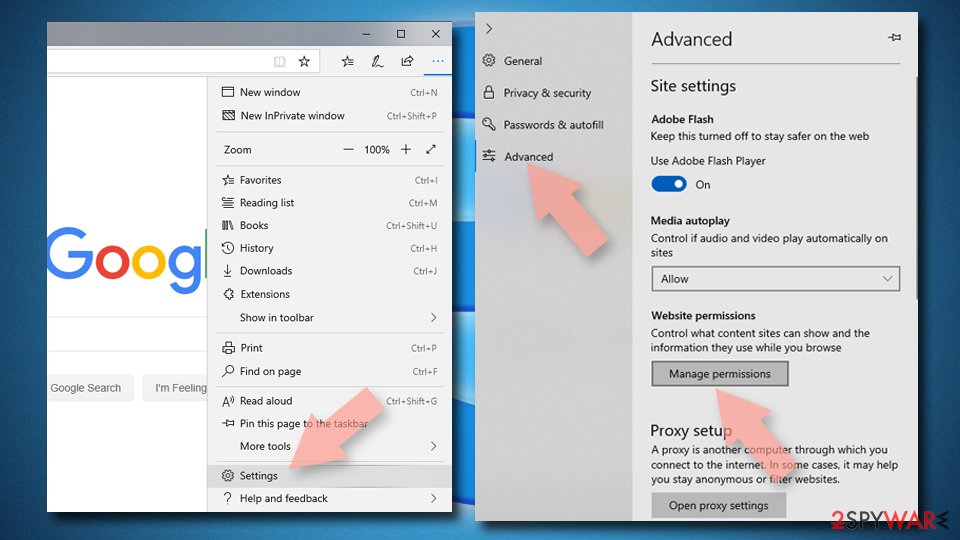
- Toggle the switch to the left to turn notifications off on Microsoft Edge.
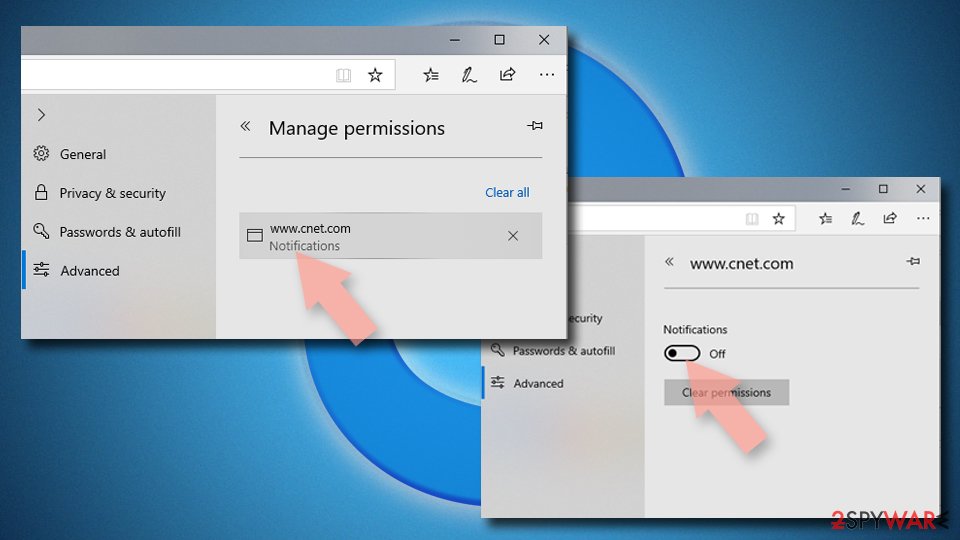
Remove unwanted notifications from MS Edge (Chromium):
- Open Microsoft Edge, and go to Settings.
- Select Site permissions.
- Go to Notifications on the right.
- Under Allow, you will find the unwanted entry.
- Click on More actions and select Block.
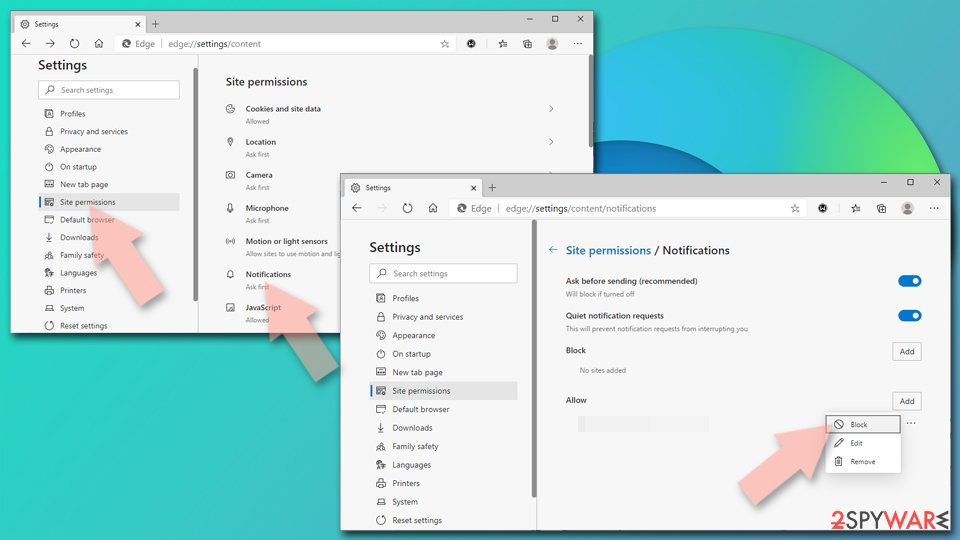
Remove unwanted notifications from Internet Explorer:
- Open Internet Explorer, and click on the Gear icon at the top-right of the window.
- Select Internet options and go to the Privacy tab.
- In the Pop-up Blocker section, click on Settings.
- Locate web address in question under Allowed sites and pick Remove.
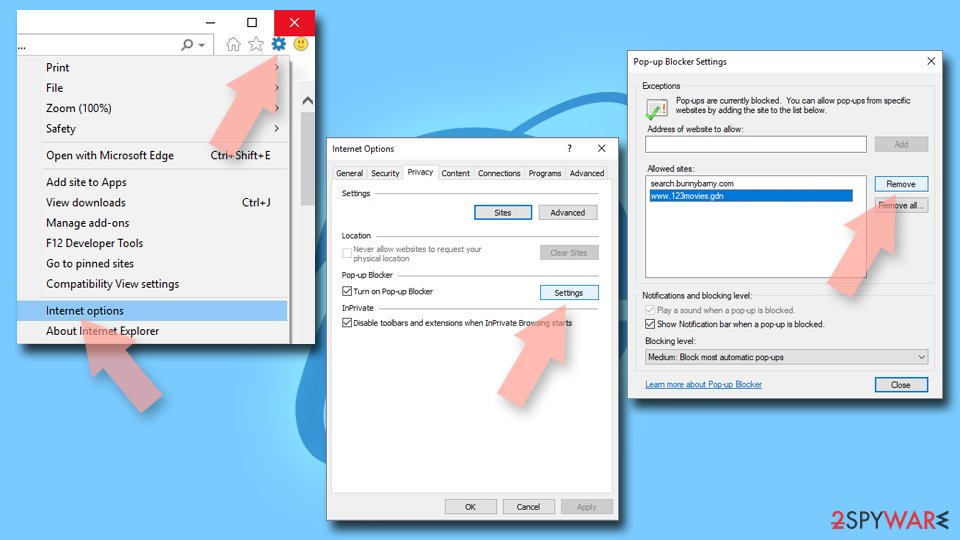
Uninstall from Windows
Instructions for Windows 10/8 machines:
- Enter Control Panel into Windows search box and hit Enter or click on the search result.
- Under Programs, select Uninstall a program.

- From the list, find the entry of the suspicious program.
- Right-click on the application and select Uninstall.
- If User Account Control shows up, click Yes.
- Wait till uninstallation process is complete and click OK.

If you are Windows 7/XP user, proceed with the following instructions:
- Click on Windows Start > Control Panel located on the right pane (if you are Windows XP user, click on Add/Remove Programs).
- In Control Panel, select Programs > Uninstall a program.

- Pick the unwanted application by clicking on it once.
- At the top, click Uninstall/Change.
- In the confirmation prompt, pick Yes.
- Click OK once the removal process is finished.
Delete from macOS
Remove items from Applications folder:
- From the menu bar, select Go > Applications.
- In the Applications folder, look for all related entries.
- Click on the app and drag it to Trash (or right-click and pick Move to Trash)

To fully remove an unwanted app, you need to access Application Support, LaunchAgents, and LaunchDaemons folders and delete relevant files:
- Select Go > Go to Folder.
- Enter /Library/Application Support and click Go or press Enter.
- In the Application Support folder, look for any dubious entries and then delete them.
- Now enter /Library/LaunchAgents and /Library/LaunchDaemons folders the same way and terminate all the related .plist files.

Uninstall from Android
Uninstall unwanted programs from Android device:
- Go to Settings -> Apps/Applications.
- Expand the full list of the installed apps.
- Scroll through the list and tap on a suspicious application once.
- Tap on it and select Uninstall.
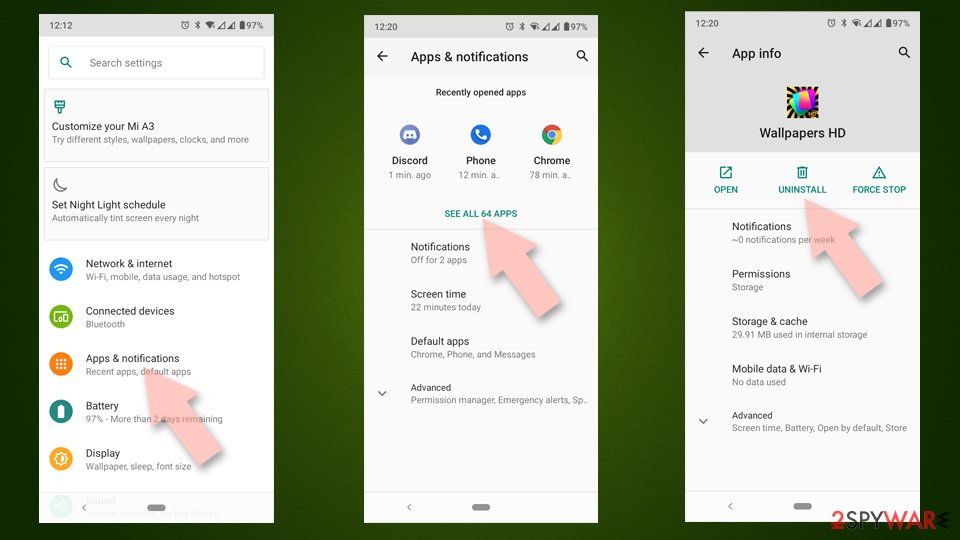
- Reboot the device.
Clear Storage and data files on Android from Google Chrome or other apps:
- Go to Settings > Apps/Applications.
- Expand the full list of the installed apps.
- Tap on Chrome and select Storage & cache.
- Clear storage and clear cache of the app.
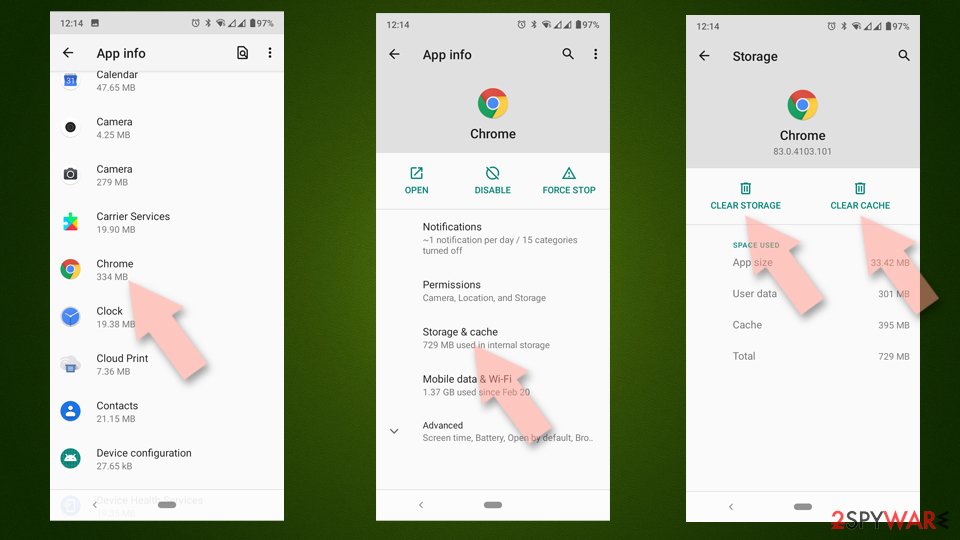
If you are seeing ads on top of other apps but are not sure what is causing it, perform the following steps:
- Go to Apps/Applications.
- Tap Advanced.
- Select Special App access.
- Tap on Display over other apps.
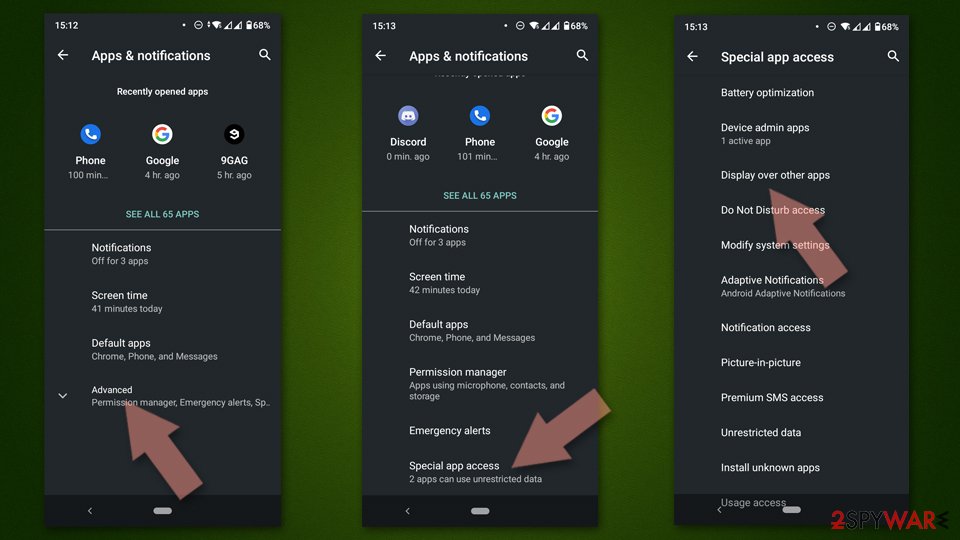
- Eliminate apps with these access rights enabled.
Remove from Microsoft Edge
Delete unwanted extensions from MS Edge:
- Select Menu (three horizontal dots at the top-right of the browser window) and pick Extensions.
- From the list, pick the extension and click on the Gear icon.
- Click on Uninstall at the bottom.

Clear cookies and other browser data:
- Click on the Menu (three horizontal dots at the top-right of the browser window) and select Privacy & security.
- Under Clear browsing data, pick Choose what to clear.
- Select everything (apart from passwords, although you might want to include Media licenses as well, if applicable) and click on Clear.

Restore new tab and homepage settings:
- Click the menu icon and choose Settings.
- Then find On startup section.
- Click Disable if you found any suspicious domain.
Reset MS Edge if the above steps did not work:
- Press on Ctrl + Shift + Esc to open Task Manager.
- Click on More details arrow at the bottom of the window.
- Select Details tab.
- Now scroll down and locate every entry with Microsoft Edge name in it. Right-click on each of them and select End Task to stop MS Edge from running.

If this solution failed to help you, you need to use an advanced Edge reset method. Note that you need to backup your data before proceeding.
- Find the following folder on your computer: C:\\Users\\%username%\\AppData\\Local\\Packages\\Microsoft.MicrosoftEdge_8wekyb3d8bbwe.
- Press Ctrl + A on your keyboard to select all folders.
- Right-click on them and pick Delete

- Now right-click on the Start button and pick Windows PowerShell (Admin).
- When the new window opens, copy and paste the following command, and then press Enter:
Get-AppXPackage -AllUsers -Name Microsoft.MicrosoftEdge | Foreach {Add-AppxPackage -DisableDevelopmentMode -Register “$($_.InstallLocation)\\AppXManifest.xml” -Verbose

Instructions for Chromium-based Edge
Delete extensions from MS Edge (Chromium):
- Open Edge and click select Settings > Extensions.
- Delete unwanted extensions by clicking Remove.

Clear cache and site data:
- Click on Menu and go to Settings.
- Select Privacy, search and services.
- Under Clear browsing data, pick Choose what to clear.
- Under Time range, pick All time.
- Select Clear now.

Reset Chromium-based MS Edge:
- Click on Menu and select Settings.
- On the left side, pick Reset settings.
- Select Restore settings to their default values.
- Confirm with Reset.

Remove from Mozilla Firefox (FF)
Remove dangerous extensions:
- Open Mozilla Firefox browser and click on the Menu (three horizontal lines at the top-right of the window).
- Select Add-ons.
- In here, select unwanted plugin and click Remove.

Reset the homepage:
- Click three horizontal lines at the top right corner to open the menu.
- Choose Options.
- Under Home options, enter your preferred site that will open every time you newly open the Mozilla Firefox.
Clear cookies and site data:
- Click Menu and pick Settings.
- Go to Privacy & Security section.
- Scroll down to locate Cookies and Site Data.
- Click on Clear Data…
- Select Cookies and Site Data, as well as Cached Web Content and press Clear.

Reset Mozilla Firefox
If clearing the browser as explained above did not help, reset Mozilla Firefox:
- Open Mozilla Firefox browser and click the Menu.
- Go to Help and then choose Troubleshooting Information.

- Under Give Firefox a tune up section, click on Refresh Firefox…
- Once the pop-up shows up, confirm the action by pressing on Refresh Firefox.

Remove from Google Chrome
Delete malicious extensions from Google Chrome:
- Open Google Chrome, click on the Menu (three vertical dots at the top-right corner) and select More tools > Extensions.
- In the newly opened window, you will see all the installed extensions. Uninstall all the suspicious plugins that might be related to the unwanted program by clicking Remove.

Clear cache and web data from Chrome:
- Click on Menu and pick Settings.
- Under Privacy and security, select Clear browsing data.
- Select Browsing history, Cookies and other site data, as well as Cached images and files.
- Click Clear data.

Change your homepage:
- Click menu and choose Settings.
- Look for a suspicious site in the On startup section.
- Click on Open a specific or set of pages and click on three dots to find the Remove option.
Reset Google Chrome:
If the previous methods did not help you, reset Google Chrome to eliminate all the unwanted components:
- Click on Menu and select Settings.
- In the Settings, scroll down and click Advanced.
- Scroll down and locate Reset and clean up section.
- Now click Restore settings to their original defaults.
- Confirm with Reset settings.

Delete from Safari
Remove unwanted extensions from Safari:
- Click Safari > Preferences…
- In the new window, pick Extensions.
- Select the unwanted extension and select Uninstall.

Clear cookies and other website data from Safari:
- Click Safari > Clear History…
- From the drop-down menu under Clear, pick all history.
- Confirm with Clear History.

Reset Safari if the above-mentioned steps did not help you:
- Click Safari > Preferences…
- Go to Advanced tab.
- Tick the Show Develop menu in menu bar.
- From the menu bar, click Develop, and then select Empty Caches.

After uninstalling this potentially unwanted program (PUP) and fixing each of your web browsers, we recommend you to scan your PC system with a reputable anti-spyware. This will help you to get rid of Revercecaptcha.com registry traces and will also identify related parasites or possible malware infections on your computer. For that you can use our top-rated malware remover: FortectIntego, SpyHunter 5Combo Cleaner or Malwarebytes.
How to prevent from getting adware
Choose a proper web browser and improve your safety with a VPN tool
Online spying has got momentum in recent years and people are getting more and more interested in how to protect their privacy online. One of the basic means to add a layer of security – choose the most private and secure web browser. Although web browsers can't grant full privacy protection and security, some of them are much better at sandboxing, HTTPS upgrading, active content blocking, tracking blocking, phishing protection, and similar privacy-oriented features. However, if you want true anonymity, we suggest you employ a powerful Private Internet Access VPN – it can encrypt all the traffic that comes and goes out of your computer, preventing tracking completely.
Lost your files? Use data recovery software
While some files located on any computer are replaceable or useless, others can be extremely valuable. Family photos, work documents, school projects – these are types of files that we don't want to lose. Unfortunately, there are many ways how unexpected data loss can occur: power cuts, Blue Screen of Death errors, hardware failures, crypto-malware attack, or even accidental deletion.
To ensure that all the files remain intact, you should prepare regular data backups. You can choose cloud-based or physical copies you could restore from later in case of a disaster. If your backups were lost as well or you never bothered to prepare any, Data Recovery Pro can be your only hope to retrieve your invaluable files.
- ^ Robert Izquierdo. 10 Types of Malware and How to Spot Them. Fool. Software reviews and recommendations.
- ^ Potentially unwanted program. Wikipedia. The free encyclopedia.
- ^ Senzavirus. Senzavirus. Spyware news and security.
